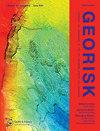空间变化土壤中边坡系统的代表性滑面识别与可靠性分析
IF 4.8
3区 工程技术
Q1 ENGINEERING, GEOLOGICAL
Georisk-Assessment and Management of Risk for Engineered Systems and Geohazards
Pub Date : 2022-08-16
DOI:10.1080/17499518.2022.2112697
引用次数: 3
摘要
摘要边坡系统是一个具有多个潜在滑面(PSS)的串联系统,其失效概率通常通过几个重要的失效面或代表性滑面(RSS)来评估。以往的工作主要从不同PSS之间的相关性角度来确定空间可变土壤中的RSSs,很少考虑PSS失效概率的影响。为了从系统故障概率的角度识别RSSs,提出了一种采用二阶可靠性方法和多模态优化的方法。在该方法中,沿滑动面的土壤性质的空间变异性通过局部平均来表征,以减少SORM中的变量数量。导出了用于计算具有相关变量的不同PSS之间的相关系数的方程。RSS识别任务被转换为多模式优化问题,对系统故障概率做出重大贡献的PSS被确定为RSS。通过两个边坡实例对所提出的方法和推导的方程进行了验证。结果表明,该方法能够识别具有显著贡献的RSSs,并对系统故障概率提供了适当的估计。本文章由计算机程序翻译,如有差异,请以英文原文为准。
Representative slip surface identification and reliability analysis of slope systems in spatially variable soils
ABSTRACT A slope system is a series system with numerous potential slip surfaces (PSSs), and its failure probability is commonly evaluated by several significant failure surfaces, or representative slip surfaces (RSSs). Previous efforts have mainly identified the RSSs in spatially variable soils from the perspective of the correlations between different PSSs, the effects of the failure probabilities of the PSSs were rarely considered. With the goal of identifying RSSs from the perspective of the system failure probability, a method adopting the second-order reliability method (SORM) and the multimodal optimisation is proposed. In this method, the spatial variability of soil properties along the slip surface is characterised by local averaging to reduce the number of variables in SORM. Equations for calculating the correlation coefficient between different PSSs with correlated variables are derived. The task of RSS identification is transformed as a multimodal optimisation problem, and the PSSs that make great contributions to the system failure probability are determined as RSSs. The proposed method and the derived equations are demonstrated using two slope examples. The results show that the proposed method is capable of identifying RSSs with significant contributions, and it provides a proper estimate of the system failure probability.
求助全文
通过发布文献求助,成功后即可免费获取论文全文。
去求助
来源期刊
CiteScore
8.70
自引率
10.40%
发文量
31
期刊介绍:
Georisk covers many diversified but interlinked areas of active research and practice, such as geohazards (earthquakes, landslides, avalanches, rockfalls, tsunamis, etc.), safety of engineered systems (dams, buildings, offshore structures, lifelines, etc.), environmental risk, seismic risk, reliability-based design and code calibration, geostatistics, decision analyses, structural reliability, maintenance and life cycle performance, risk and vulnerability, hazard mapping, loss assessment (economic, social, environmental, etc.), GIS databases, remote sensing, and many other related disciplines. The underlying theme is that uncertainties associated with geomaterials (soils, rocks), geologic processes, and possible subsequent treatments, are usually large and complex and these uncertainties play an indispensable role in the risk assessment and management of engineered and natural systems. Significant theoretical and practical challenges remain on quantifying these uncertainties and developing defensible risk management methodologies that are acceptable to decision makers and stakeholders. Many opportunities to leverage on the rapid advancement in Bayesian analysis, machine learning, artificial intelligence, and other data-driven methods also exist, which can greatly enhance our decision-making abilities. The basic goal of this international peer-reviewed journal is to provide a multi-disciplinary scientific forum for cross fertilization of ideas between interested parties working on various aspects of georisk to advance the state-of-the-art and the state-of-the-practice.

 求助内容:
求助内容: 应助结果提醒方式:
应助结果提醒方式:


